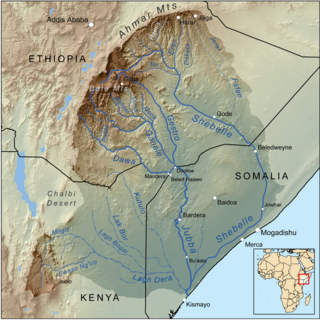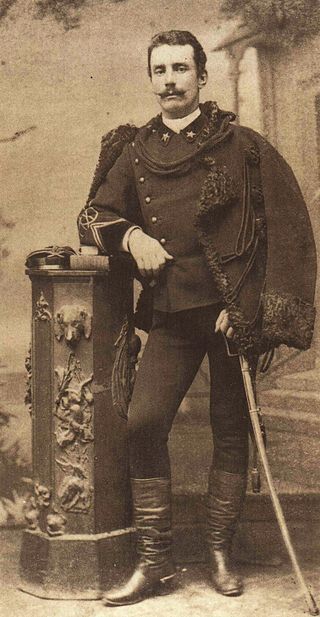
Middle Juba is an administrative region (gobol) in southern Somalia. With its capital at Bu'aale, it is located in the autonomous Jubaland region.

Lower Juba is an administrative region (gobol) in southern Somalia. With its capital at Kismayo, it lies in the autonomous Jubaland region. It has green forests and wildlife including lions, giraffes, hippos, crocodiles, and hyenas.
A hydraulic empire, also known as a hydraulic despotism, hydraulic society, hydraulic civilization, or water monopoly empire, is a social or government structure which maintains power and control through exclusive control over access to water. It arises through the need for flood control and irrigation, which requires central coordination and a specialized bureaucracy.

The Shebelle River begins in the highlands of Ethiopia, and then flows southeast into Somalia towards Mogadishu. Near Mogadishu, it turns sharply southwest, where it follows the coast. Below Mogadishu, the river becomes seasonal. During most years, the river dries up near the mouth of the Jubba River, while in seasons of heavy rainfall, the river actually reaches the Jubba and thus the ocean.

Vittorio Bottego was an Italian army officer and one of the first Western explorers of Jubaland in the Horn of Africa, where he led two expeditions. He was an artillery captain in the Italian Army.

Kismayo is a port city in the southern Lower Juba province of Somalia. It is the commercial capital of the autonomous Jubaland region.
The Bajuni Islands are an archipelago in southern Somalia. They are situated in the Somali sea off the southern coast of Jubaland, from Kismayo to Ras Kiyamboni.
The Garre are a prominent Somali clan that traces its lineage back to Samaale, who is believed to have originated from the Arabian Peninsula through Aqiil Abu Talib. The Garre clan is considered to be a sub-clan of the Digil-Rahanweynl clan family, which is part of the larger Rahanweyn clan. However, genealogically, they are descended from Gardheere Samaale. The Garre are also categorized as southern Hawiye as well.

Bardere is a district in the southwestern Gedo region in Jubaland State of Somalia. It is the second largest and most populous city in Jubaland with Kismayo being the largest and most densely populated city in the region. Bardera sits on the Jubba River around 250 km west of the city of Baidoa and is in a highland area with fertile soil. The city experiences extremely hot temperatures from December to April and heavy rainfalls from April to May knowns as Gu (spring) The city was formerly known as the "Onion capital of the World" for its production of the vegetable, the name Bardere means tall palm trees. The palms were cut to construct native homes or midille.

The Rahanweyn, also known as the Digil and Mirifle are a major Somali clan. It is one of the major Somali clans in the Horn of Africa, with a large territory and densely populated fertile valleys of the Jubba and Shebelle rivers and the area between are mainly inhabited by settlers from the Digil and Mirifle lineages.

The Jubba Valley is a valley in East Africa.

The Ajuran Sultanate, also natively referred-to as Ajuuraan, and often simply Ajuran, was a Somali Empire in the Middle Ages in the Horn of Africa that dominated the trade in the northern Indian ocean. They belonged to the Somali Muslim sultanate that ruled over large parts of the Horn of Africa in the Middle Ages. Through a strong centralized administration and an aggressive military stance towards invaders, the Ajuran Empire successfully resisted an Oromo incursion from the west and a Portuguese incursion from the east during the Gaal Madow and the Ajuran-Portuguese wars. Trading routes dating from the ancient and early medieval periods of Somali maritime enterprise were strengthened or re-established, and foreign trade and commerce in the coastal provinces flourished with ships sailing to and coming from many kingdoms and empires in East Asia, South Asia, Europe, the Near East, North Africa and East Africa.
Jilib is a city in Middle Jubba Region in Somalia, It is 112 kilometres or 70 miles north of Kismaayo. Mainly inhabited by the Sheekhaal clan.

The Bimaal or Bimal, is a sub-clan of the major Dir clan family. This clan is widely known for leading a resistance against the colonials in southern Somalia for decades which can be -in a little way- compared to the war of the Sayyid in Somaliland. The Biimaal mainly lives in southern Somalia, the Somali region of Ethiopia, which their Gaadsen sub-clan mainly inhabits and in the NEP region of Kenya.

Luuq is a city in the southwestern Gedo province of Somalia. It is one of the older settlements in the area. It is the seat of the Luuq District. The town is located in a bend of the Juba River, where the watercourse flows down from north to south in a horseshoe shape. Luuq is also known as Luuq Gan naane.

Oltre Giuba or Trans-Juba was an Italian colony in the territory of Jubaland in present-day southern Somalia. It lasted from 1924 until 1926, when it was absorbed into Italian Somaliland. Trans-juba is the former name of Jubaland, a federal member state of Somalia.

The Ganale Doria River is a perennial river in southeastern Ethiopia. Rising in the mountains east of Aleta Wendo, the Ganale flows south and east to join with the Dawa at the border with Somalia to become the Jubba. The river's tributaries include the Welmel, Weyib, Dumale, Doya, Hawas and the Hambala. The Del Verme Falls is a notable feature of its middle course.

Jubaland, the Juba Valley or Azania, is a Federal Member State in southern Somalia. Its eastern border lies 40–60 km (25–35 mi) east of the Jubba River, stretching from Gedo to the Indian Ocean, while its western side flanks the North Eastern Province in Kenya, which was carved out of Jubaland during the colonial period.

Ganale Doria is a dam located near Genale on the river Shabelle. It was built in the south of Somalia in the 1920s along with an extensive network of canals. The dam was strongly promoted by Cesare Maria De Vecchi - Italian governor of Italian Somalia from 1924 to 1928 - in order to provide water for irrigation of a vast territory between Genale, Merca and Vittorio di Africa, to be given in concession to colonists.

The Jubba Basin, also called Goobweyn Hoose, is a drainage outlet in Jubaland, Somalia and is the point at which the River Jubba meets the Somali Sea. Since the Shebelle River's outlet joins Jubba as a tributary, it is also the outlet of the Shebelle River.













